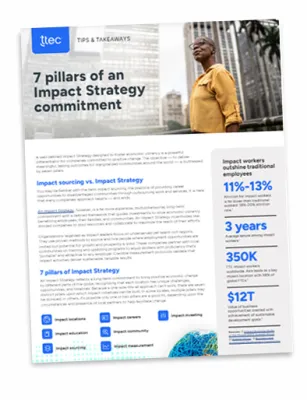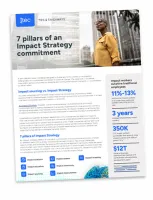Companies across industries are well aware that customer experience has become the single most important differentiator within today’s competitive market. However, many leaders overlook the fact that success typically emerges from the inside out—customer service can only be as good as the associates who serve the customer.
Many organizations may not realize their full potential if they do not harness their greatest source for insight: their people. You see, while strategists and decision-makers focus heavily on honing the customer experience, many fail to recognize the unyielding significance of employee engagement and morale, particularly in the critical contact center channel.
Most companies can confidently say that they understand what customers want from their brand experience, at least to some extent. But they cannot deliver an optimal experience if their contact center representatives are dissatisfied with their environment or are not equipped with the proper tools to bring initiatives to fruition. Leaders must embrace voice of the employee programs to boost communication and foster dialogue in order to engage and excite associates.
Though contact center representatives operate along the front line of the customer experience, they can easily become detached from the internal company culture. They’re constantly in tune with customer sentiment, yet they rarely have the opportunity to share their knowledge and opinions. This lack of visibility can ultimately lead to attrition.
How can business leaders elevate voice of the employee in ways that move beyond superficial, antiquated methods, such as employee engagement surveys, to tackle truly deep issues and inevitably bring this insight to action? First, they must stop to assess the company’s current situation. Then, they must look at what tools and technologies they need to implement. Finally, they must listen to employees by establishing clear lines of communication that extend from the top of the C-suite all the way down to the front line.
Stop
Leaders need to step back and analyze the current issues that may lead to low employee morale in the contact center. Many issues are operational, not attitudinal. One of the most common operational areas to review is the fact that few companies empower employees to make their own decisions to do what’s right for individual customers.
In these cases, employees cannot propose solutions or apply credits to a customer’s account without escalating the call to management. This diminishes the experience for both the customer and the associate. Customers are forced to endure longer than average handle times, while associates feel inefficient and inadequate because they do not have the authority to provide the best brand experience possible.
To guarantee the highest level of employee satisfaction, leaders must establish guidelines that facilitate the average customer service interaction, while also empowering associates to operate outside these parameters when the circumstance arises. Investment in employee training and clear protocols is an essential component of this initiative, so everyone understands the boundaries of what can and can’t be done.
In addition, trust plays a key factor in success. Employees cannot be confident in their decisions if leaders do not demonstrate clear trust and faith in their actions. Leaders must create an atmosphere dedicated to trust and honesty if they wish to keep contact center associates from second guessing their every move.
Look
Technology plays an integral role in the contact center culture of today, and the tools provided have the power to make or break employee engagement and customer experience. Companies should invest in the tools and technologies that foster frictionless experiences. To start, brands must bring customer information from across channels together in one platform or dashboard.
Customers want to connect with their favorite companies via the channel of their choice, and leaders are doing an increasingly good job of making this dream a reality. However, they must also enable associates to respond and react to these cross-channel queries by funneling each customer’s brand history into one channel, as well.
Contact center associates cannot offer superior service if they must jump around numerous systems to find the data they need. Employees who must navigate multiple systems and screens will likely become just as frustrated as customers. In this scenario, associates cannot act as experts. In many cases, they won’t even be able to help at all. Only one all-powerful portal of information can provide the meaningful service they wish to convey to their customer base.
Systems and tools must be integrated so employees have all the information they need at their fingertips to resolve a customer issue. This will require investment in knowledge management systems, data warehouses, and a variety of CRM or customer management tools. And if possible, allow employees to contribute to the knowledgebase with their expertise, to keep the insight up-to-date and relevant in real time.
Listen
Beyond all else, leaders must listen to what their employees have to say. These individuals can provide valuable insight into both the internal and external brand experience. From food quality complaints to persistent customer questions, employee knowledge runs the gamut. If leaders ever hope to make informed decisions, employee insight isn’t just useful—it’s essential.
While employee engagement surveys still provide valuable insight into the contact center experience, brands must look past these more traditional methods in order to understand perspectives that may otherwise remain dormant.
Town Hall meetings are an effective way to get employees talking, for instance, because bringing those associates with shared experiences together in one room allows each participant to connect and relate with their fellow colleagues. Once one employee dares to speak up, the rest will undoubtedly chime in, thereby fostering the dialogue leaders have been searching for all along. Once the gates to clear, honest communication have opened, employees will finally have their much-deserved seat at the table.
For example, transparency invites dialogue and promotes honesty. Having a clear and well communicated “definition of success” will keep employees well-informed of progress toward collective goals. As you communicate how you’re performing against the plan, ask for employee feedback on how to do better, what’s getting in the way, what to do next, etc., and be sure to incorporate that in to your plan.
Also, it’s important to be present and opportunistic. Take advantage of the opportunity you have when you casually interact with employees. Sit with them on break in the break room, stop and chat as you enter or exit the building, take a walk on break, or pause in the halls to engage with someone. Get to know someone new, ask them about how their day is going, see if there is anything they need or anything preventing them from giving it their all today, and if they answer, listen.
However, listening also requires action. It’s not enough to simply turn your ear to the possibilities. Leaders must create an action plan for bringing pertinent suggestions to fruition. Employees will appreciate having their voices heard, but all will be for naught if their words never produce noticeable culture change. Be sure to communicate with employees if their ideas have turned into change within the company. The feedback loop is essential for keeping your promises to employees.
In the end, contact center culture must be built upon clear communication that echoes through every level of the enterprise. Leaders cannot create an effective outward relationship with customers if they have yet to establish such bonds with their internal employees. If employee experience falters, so will customer experience by default. But, by implementing the strategies and technologies that promote dialogue and action, companies can lay the foundation for long-term employee satisfaction, engagement, and happiness.















